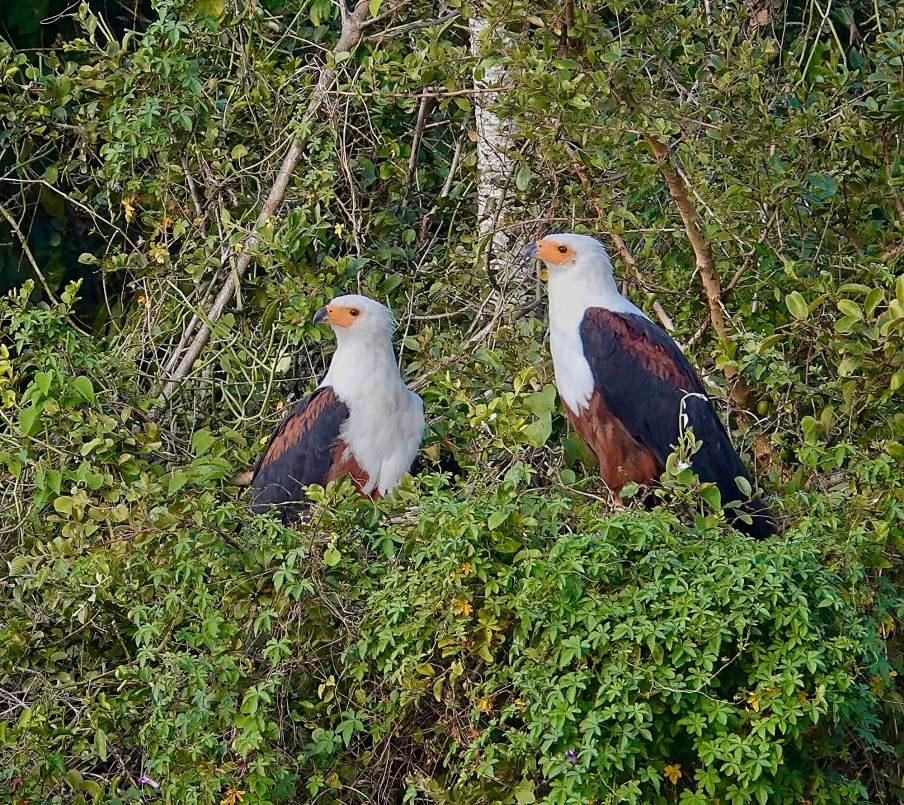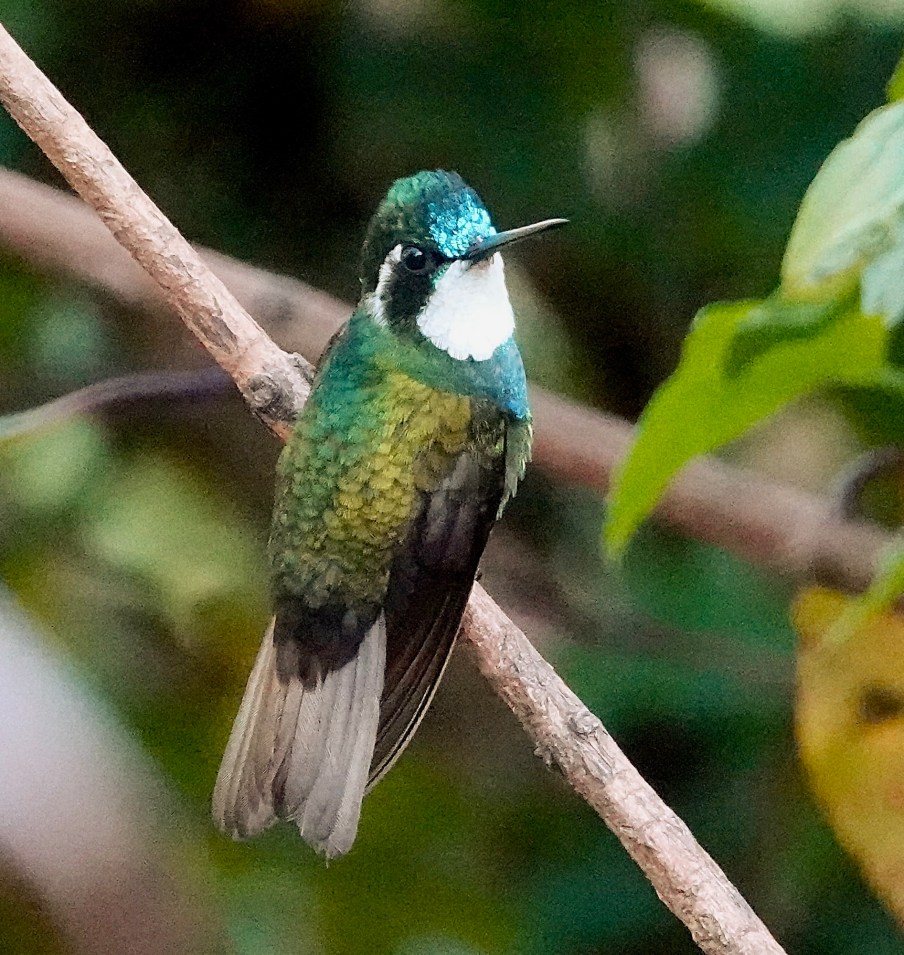Uganda Edition: Striped Kingfisher

Striped Kingfisher: Lake Mburo National Park, Uganda, August 2022 — After a restful night at our lodge were were up early for our dawn walking safari in the park. This trip we drove into the park a good ways to an area around one of the larger water dams before setting off on foot. Our very first encounter was this little Striped Kingfisher, common in the park, but always a good bird. I like Kingfishers 🙂 Still before sun-rise here, so the light was not the best. Sony Rx10iv at 600mm equivalent. Program mode with my custom birds and wildlife modifications. Processed in Pixelmator Pro and Apple Photos. ISO 1250 @ f4 @ 1/500th.
Lesser Violet-ear display

Lesser Violet-ear: Miriam’s Quetzals, San Gerardo de Dota, Costa Rica, December 2022 — Lesser Violet-ears are among the most aggressive of hummingbirds, defending territory and feeders from all-comers, excluding much larger hummers. Therefore you are much more likely to see on in full offensive posture than you are most hummingbirds. The things they do with there gorgets are amazing, and this one does not yet have its ears out! Sony Rx10iv at 600mm equivalent. Program mode with my custom birds and wildlife modifications. Processed in Pixelmator Photo and Apple Photos. ISO 2000 @ f4 @ 1/500th.
Uganda Edition: African Fish Eagle

African Fish Eagle: Lake Mburo National Park, Uganda, August 2022 — There were more Fish Eagles along the shore of Lake Mburo than I have ever seen elsewhere…and that is saying quite a lot, as they are common bird all through sub-Saharan Africa wherever there is water. This pair posed about as nicely as you could want. Sony Rx10iv at 600mm equivalent. Program mode with my custom birds and wildlife modifications. Processed in Pixelmator Photo and Apple Photos. ISO 320 @ f4 @ !/500th.
Resplendent Quetzal

Resplendent Quetzal: San Gerardo de Dota, Costa Rica, December 2022 — To see the Resplendent Quetzal you get up well before dawn and drive to whatever wild avocado tree is in fruit at the moment. Everyone in the valley knows which trees are in fruit today, and where the Quetzals are, since, in large part, it is these birds that bring the tourists who keep the valley prosperous. I should say that there are wild avocado trees all up and down the valley. Most are deep in the forest, but a few are accessible from the road for with a short, manageable, climb up or down from the road. And each tree has its own unique fruiting season…they do not fruit all at once…generally just one or two trees at a time. December is good month to find and photograph Quetzals in San Gerardo de Dota because a few of the fruiting trees are close to the road. Once you reach the tree, you climb out of the bus, do your little climb as needed, and stand with 30 to 50 others who have braved the dawn for the Quetzal, and wait. Among the group are several guides who live in the valley and are there, wherever the Quetzals are, every dawn. These folks are the most likely to see the birds first as they know the habits and behaviors of the moment. When the first Quetzal comes in, often before full light…often well before there is really enough light for photography…the whole group shifts like a folk of starlings in flight to reform where there is a view. With patience, as the sun rises higher and crests the high ridges to the east of the valley, and the light improves, the Quetzals will come to a tree out in the open for fruit, generally taking one in flight. They then perch, hopefully on a branch where they can be seen, and sit a while before swallowing the fruit whole, and then while they begin digestion. They will sit there for anything from a few moments to a quarter of an hour, before returning to the tree to feed. And all the time the light is improving and the crowd of tourists is thinning, as the non-photographers have seen their Quetzal and breakfast and coffee is waiting at the lodge. Only a few hardy souls wait for the sun to get above the tall mountains and light to flood the valley. Occasionally the Quetzals will still there there, and that is when the good photos happen. 🙂 Eventually the Quetzals have their fill and fly off deeper into the forest to find another tree, but generally even the most dedicated photographers are back at the lodge for breakfast by then. Sony Rx10iv at 543mm equivalent. Program mode with my custom birds and wildlife modifications. Processed in Pixelmator Pro and Apple Photos. ISO 640 @ f4 @ 1/500th. Plus .7EV.
Uganda Edition: Pied Kingfishers
Pied Kingfishers: Lake Mburo National Park, Uganda, August 2022 — To say that we saw a lot of Pied Kingfishers from the Lake Mburo tour boat would be somewhat of an understatement. They were everywhere…so much so that I only took photos of major concentrations! Bush and branchfuls. Sony Rx10iv at 600mm equivalent. Program mode with my custom birds and wildlife modifications. Processed in Pixelmator Photo and Apple Photos. ISO 320 and 100 @ f4 @ 1/500th.
Large-footed Finch

Large-footed Finch: Miriam’s Quetzels Restaurant, San Gerardo de Dota, Costa Rica, December 2022 — Not the most exciting bird in the world, but another mountain speciality…hugging the area from cloud forest up to tree-line. It’s behavior is very like our North American Robin…scratching for invertebrates in the grass and leaf litter. And, yes, it does have large feet! Sony Rx10iv at 600mm equivalent. Program mode with my custom birds and wildlife modifications. Processed in Pixelmator Photo and Apple Photos. ISO 4000 @ f4 @ 1/500th.
Uganda Edition: Crakes over Croc

Black Crake: Lake Mburo National Park, Uganda, August 2022 — I remember how excited I was to see my first Black Crake along a stream in Masi Mara several years ago now…in Uganda they are common along most bodies of water and streams. These were feeding at the edge of Lake Mburo when we passed on the tour boat. That is a huge Crocodile in the foreground. 🙂 Sony Rx10iv at 600mm equivalent. Program mode with my custom birds and wildlife modifications. Processed in Pixelmator Photo and Apple Photos. ISO 800 @ f4 @ 1/500th.
White-treated Mountain-Gem

White-throated Mountain-Gem: Miriam’s Quetzals Restaurant, San Geraldo de Dota, Costa Rica, December 2022 — The White-throated Mountain-Gem is, in my experience, the Gem found at the highest elevations in Costa Rica. I had only seen the Purple-throated in the high foothills, and, if memory serves, I have never seen the White-bellied. I have seen way more female White-throated Mountain-Gems than males, so it was nice to see this one off the deck at Miriams on our first stop there. Sony Rx10iv at 600mm equivalent. Program mode with my custom birds and wildlife modifications. Processed in Pixelmator Pro and Apple Photos. ISO 4000 @ f4 @ 1/500th.
Uganda Edition: Croc #2

Nile Crocodile, Lake Mburo National Park, Uganda, August 2022 — One Croc deserves another…this one is slightly smaller than the one I posted yesterday, but then most crocs would be. This is maybe 12 feet long, and not so massive…and is showing off all its teeth. As cold-blooded animals, Crocodiles hold their mouths open to lower their body temperatures on warm days. Sony Rx10iv at 600mm equivalent. Program mode with my custom birds and wildlife modifications. Processed in Pixomator Pro and Apple Photos. ISO 400 @ f4 @ 1/500th.
Long Sands Beach, York, Maine

Long Sands Beach, York, Maine, February 2023 — I got on the wrong road coming back from York Hospital where I had a Travel Medicine appointment yesterday, and came up the coast a ways. Not the first time it has happened. I don’t go to York enough to know where I am. Still, it was a beautiful afternoon in February, and I stopped along Long Sands, south of Nubble Light, for this iPhone ultra-wide shot. Auto exposure (which has HDR always engaged on my iPhone 13). Processed in Apple Photos.

